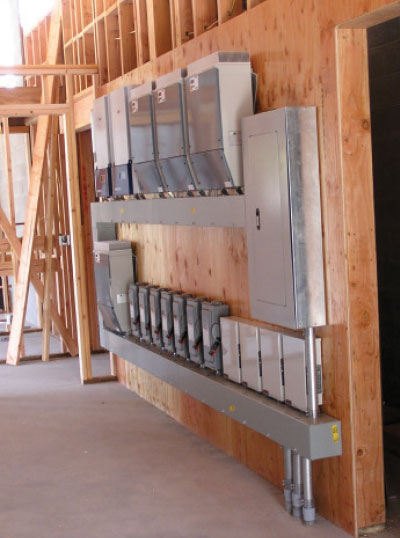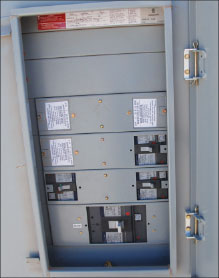Article 690
690.2 Definitions.
DC to DC Converters are defined but little information will be found on how they are to be installed. The AHJs and the installer will have to rely on the instruction manual for these listed devices and NEC Section 110.3 B.
Various types of combiners such as source circuit combiners and re-combiners and other types of dc combiners have been combined into one definition: Direct-Current (dc) Combiner.
A Multimode Inverter is defined and this device will be appearing in the ever-increasing numbers of battery-backed-up, utility-interactive systems.
690.4 General Requirements.
The identification and grouping requirements have been moved to section 690.31. DC-to-DC converters have been added to the listed equipment requirement. Bipolar PV systems are required to have a warning concerning overvoltage on equipment if the grounded conductors are disconnected.
690.5 Ground-Fault Protection.
These devices are now required to recognize ground faults in intentionally grounded conductors, and they are now required to be listed.
690.7 Maximum Voltage.
The 600-V limit in one- and two-family dwellings has been raised to 1000 V.
For energy storage devices, significant details of the requirements for disconnects and overcurrent protection have been added.
690.9 Overcurrent Protection.
Circuits connected to current-limited sources such as PV modules and utility-interactive inverters shall be protected from overcurrents at the source of those overcurrents, usually external sources. The rating of overcurrent devices now must consider terminal temperature requirements and operation in environments over 40° C. Overcurrent devices listed for PV applications shall be required in the dc PV circuits. In ungrounded PV arrays, overcurrent protection must be installed in each undergrounded conductor where circuit overcurrent protection is required.
Transformers connected to the output of utility interactive inverters with a rating the same as the utility interactive inverter are not required to have overcurrent protection from the inverter output.
690.12. Rapid Shutdown of PV Systems on Buildings.
This new section requires a shutdown system that is to be used by first responders/Fire Service personnel that can shut down all PV circuits on or in a building within 10 seconds of activation. The controlled conductors after the shutdown must not have any more than 30 V or 240 VA between any two conductors and any conductor and ground. Energized conductor lengths inside the building will be limited to 1.5 m (5 feet) and no more than 3 m (10 feet) from the PV array outside the building,
Specific implementation details are not included in the code. However, we can expect that the remote disconnect will be in a readily accessible location, clearly marked on the outside of the building and will probably be near the existing utility revenue meter. Circuits that will be impacted include module outputs, string outputs, combiner outputs, inverter outputs, and the dc input circuits on inverters which may be energized for up to five minutes. Energy storage devices, such as batteries, associated with the PV system will also have to be disconnected.
Section III. Disconnecting Means.
The contents of sections 690.13; 690.14; 690.15 and 690.17 have been revised and merged with 690.14 removed. Most requirements remain the same. DC combiners located on the roofs of buildings will have a load break rated disconnecting means in the combiner or within 1.8 m (6 feet). The disconnect may be controlled remotely but must have a manual operation function.
690.17 Disconnect Type.
PV disconnecting means can be power operable with a manual operation function. A number of specific disconnecting means are now shown in the code.
690.31 Methods Permitted.
Conductors and wiring that are part of a listed system are now acceptable.
Inverter outputs may no longer be grouped in the same raceway as the PV source or PV output circuits unless there is a partition in the raceway (photo 1).

Photo 1. Those raceways must have an internal partition to separate dc PV source conductors from ac inverter output conductors..
Single conductor cables listed and labeled as PV cables or PV wire are permitted in cable trays even though they are not marked for cable tray use. They must be supported at intervals not to exceed 300 mm (12 inches) and must be secured at intervals not to exceed 1.4 m (55 inches).
Multi-conductor cables Type TC-ER or USE-2 may be permitted in outdoor locations connected to the output of PV inverters where the inverters are not mounted in readily accessible locations.
Additional requirements for markings on the dc PV circuits inside and outside of buildings has been added and specifications on the types of markings will be found in this section.
Significant portions of 690.4 regarding circuit routing and grouping have been transferred to this section.
690.35 Ungrounded Photovoltaic Power Systems. Ground-Fault Protection.
The ground-fault protection equipment must now be listed.
690.41 System Grounding.
The section has been revised to indicate grounding requirements for various types of systems.
690.45 Size of Equipment Grounding Conductors.
Shortened due to the fact that all systems must have ground-fault protection now.
690.47 Grounding Electrode System.
(B) Direct-Current Systems.
The AC equipment grounding system may now be used to provide equipment grounding for ungrounded dc systems.
690.47(D) Additional Auxiliary Electrodes for Array Grounding.
This section returns from the 2008 Code after being removed from the 2011 Code and now has slight modifications for clarity.
690.53 Direct Current Photovoltaic Power Source.
Systems with multiple dc outputs shall have the output currents marked for each of the outputs.
690 Part VIII. Storage Batteries.
690.71 Installation.
(H) Disconnection Overcurrent Protection.
This new section establishes a number of significant requirements for disconnecting means and overcurrent protection for battery circuit output conductors (photo 2).

Photo 2. Battery disconnect adjacent to battery enclosure
690 Part IX. Systems over 1000 V.
This section has been revised from 600 V to 1000 V and a section 690.81 has been added indicating that listed products should be installed in accordance with the listing.
690 Part X. Electric Vehicle Charging.
This section primarily refers to other sections of Code dealing with electric vehicle charging.
Article 705
Section705.12(D) has had numerous revisions that will clarify previous code requirements and change several relating to the point of connection for utility interactive inverters on the load side of the service disconnect. These revisions will require an entire article to cover completely and that article will be in a forthcoming IAEI News (photo 3).
It appears that multiple inverter systems will require a combining panel so that there is a single AC output of the PV system to meet the dedicated point of connection requirements in 705.12(D)(1). How this affects large physical plants where the buildings (and PV systems) are scattered out or a large single building like a shopping mall with multiple PV systems is unclear.
705.12(D)(3)(d) allows connections to multi-ampacity bus works and center tapped panel boards where designed under engineering supervision that includes fault studies and busbar load calculations.
705.12(D)(6) will require listed ac AFCI protection for utility-interactive inverter outputs using exposed wire harnesses or cable operating at 240 V, 30 A, or less.
705.31 Location of Overcurrent Protection.
This new section requires that the overcurrent protection for conductors for a supply-side utility interactive inverter connection be at the point of interconnection or within 3 m (10 feet) of that point.

705.100 Unbalanced Interconnections.
(A) Single Phase.
Single-phase inverters connected to three-phase power systems shall not result in unbalanced voltages exceeding 3%.
Summary
Remember, the above information is based on the ROC and is not the final Code. Changes may occur and the published Code is the final authority. In upcoming articles, various sections of the 2014 NEC will be addressed in greater detail.
For More Information
The author has retired from the Southwest Technology Development Institute at New Mexico State University, but is devoting about 25% of his time to PV activities in order to keep involved in writing these Perspectives on PV articles in the IAEI News and to stay active in the NEC and UL Standards development. He can be reached, sometimes, at: e-mail: jwiles@nmsu.edu, Phone: 575-646-6105
The Southwest Technology Development Institute web site maintains a PV Systems Inspector/Installer Checklist and all copies of the previous “Perspectives on PV” articles for easy downloading. A color copy of the latest version (1.93) of the 150-page, Photovoltaic Power Systems and the 2005 National Electrical Code: Suggested Practices, written by the author, may be downloaded from this web site: http://www.nmsu.edu/~tdi/Photovoltaics/Codes-Stds/Codes-Stds.html
It should be updated to the 2008 and 2011 NEC before the 2014 NEC arrives.














Find Us on Socials